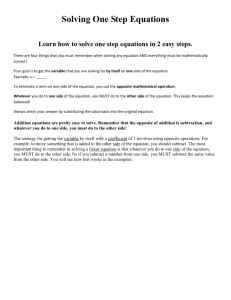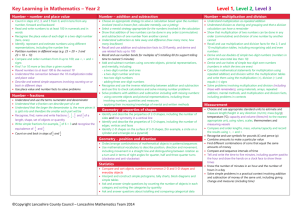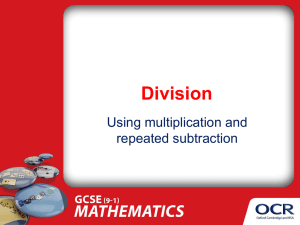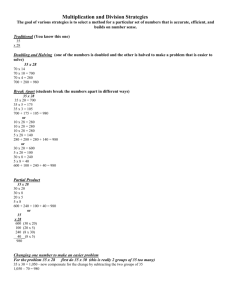Progression in Addition - Shobdon Primary School
advertisement
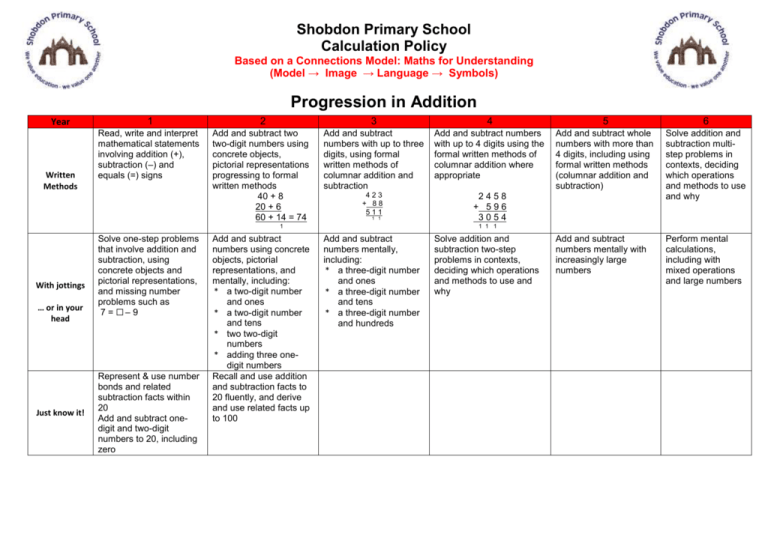
Shobdon Primary School Calculation Policy Based on a Connections Model: Maths for Understanding (Model → Image → Language → Symbols) Progression in Addition Year Written Methods 1 2 3 4 5 6 Read, write and interpret mathematical statements involving addition (+), subtraction (–) and equals (=) signs Add and subtract two two-digit numbers using concrete objects, pictorial representations progressing to formal written methods 40 + 8 20 + 6 60 + 14 = 74 Add and subtract numbers with up to three digits, using formal written methods of columnar addition and subtraction Add and subtract numbers with up to 4 digits using the formal written methods of columnar addition where appropriate Add and subtract whole numbers with more than 4 digits, including using formal written methods (columnar addition and subtraction) 423 + 88 511 2458 + 596 3054 Solve addition and subtraction multistep problems in contexts, deciding which operations and methods to use and why Add and subtract numbers mentally with increasingly large numbers Perform mental calculations, including with mixed operations and large numbers 1 1 1 With jottings … or in your head Just know it! Solve one-step problems that involve addition and subtraction, using concrete objects and pictorial representations, and missing number problems such as 7 = ☐– 9 Represent & use number bonds and related subtraction facts within 20 Add and subtract onedigit and two-digit numbers to 20, including zero Add and subtract numbers using concrete objects, pictorial representations, and mentally, including: * a two-digit number and ones * a two-digit number and tens * two two-digit numbers * adding three onedigit numbers Recall and use addition and subtraction facts to 20 fluently, and derive and use related facts up to 100 1 1 1 Add and subtract numbers mentally, including: * a three-digit number and ones * a three-digit number and tens * a three-digit number and hundreds Solve addition and subtraction two-step problems in contexts, deciding which operations and methods to use and why Shobdon Primary School Calculation Policy Based on a Connections Model: Maths for Understanding (Model → Image → Language → Symbols) Progression in Subtraction Year 1 2 3 Read, write and interpret mathematical statements involving addition (+), subtraction (–) and equals (=) signs Add and subtract two two-digit numbers using concrete objects, pictorial representations progressing to empty number line. Add and subtract numbers with up to three digits, using empty number line, progressing to expanded column subtraction (no regrouping) 356 – 122 = 234 (Find the difference) 82 – 58 = 24 300 100 200 Add and subtract numbers using concrete objects, pictorial representations, and mentally, including: * a two-digit number and ones * a two-digit number and tens * two two-digit numbers * adding three onedigit numbers Recall and use addition and subtraction facts to 20 fluently, and derive and use related facts up to 100 Add and subtract numbers mentally, including: * a three-digit number and ones * a three-digit number and tens * a three-digit number and hundreds Written Methods With jottings … or in your head Just know it! Solve one-step problems that involve addition and subtraction, using concrete objects and pictorial representations, and missing number problems such as 7 = ☐– 9 Represent and use number bonds and related subtraction facts within 20 Add and subtract onedigit and two-digit numbers to 20, including zero 50 20 30 4 5 6 Add and subtract numbers with up to 4 digits using the formal written methods of columnar subtraction where appropriate. Add and subtract whole numbers with more than 4 digits, including using formal written methods (columnar addition and subtraction) Solve addition and subtraction multistep problems in contexts, deciding which operations and methods to use and why Solve addition and subtraction two-step problems in contexts, deciding which operations and methods to use and why Add and subtract numbers mentally with increasingly large numbers Perform mental calculations, including with mixed operations and large numbers 6 2 4 = 234 Recall and use addition and subtraction facts to 20 fluently, and derive and use related facts up to 100 Shobdon Primary School Calculation Policy Based on a Connections Model: Maths for Understanding (Model → Image → Language → Symbols) Progression in Multiplication Year 1 Written Methods 2 3 4 Calculate mathematical statements for multiplication and division within the multiplication tables and write them using the multiplication (×), division (÷) and equals (=) signs Write and calculate mathematical statements for ÷ using the x tables they know progressing towards formal written Multiply two-digit and three-digit numbers by a 5 X 40 3 6 240 18 one-digit number using grid method methods, using practical equipment. With jottings … or in your head …. Just know it! Solve one-step problems involving multiplication and division, by calculating the answer using concrete objects, pictorial representations and arrays with the support of the teacher Count in multiples of twos, fives and tens Show that multiplication of two numbers can be done in any order (commutative) and division of one number by another cannot Solve problems involving multiplication and division, using materials, arrays, repeated addition, mental methods, and multiplication and division facts, including problems in contexts Recall and use x and ÷ facts for the 2, 5 and 10 x tables, including recognising odd and even numbers. Write and calculate mathematical statements for multiplication and division using the multiplication tables that they know, including for two-digit numbers times one-digit numbers, using mental methods Recall and use x and ÷ facts for the 3, 4 and 8 times tables. Use place value, known and derived facts to multiply and divide mentally, including: multiplying by 0 and 1; dividing by 1; multiplying together three numbers Recognise and use factor pairs and commutativity in mental calculations Recall x and ÷ facts for x tables up to 12 x 12. Multiply numbers up to 4 digits by a oneor two-digit number using a formal written method, including long multiplication for two-digit numbers 243 x 6 2058 1 Multiply and divide numbers mentally drawing upon known facts Multiply and divide whole numbers and those involving decimals by 10, 100 and 1000 Identify multiples and factors, including finding all factor pairs of a number, and common factors of two numbers establish whether a number up to 100 is prime Recall prime numbers up to 19 know and use the vocabulary of prime numbers, prime factors and composite (nonprime) numbers Recognise and use square numbers and cube numbers, and the notation for squared (²) and cubed (³) 6 Multiply multi-digit numbers up to 4 digits by a two-digit whole number using the formal written method of long multiplication 243 x 36 7290 1458 8748 1 Perform mental calculations, including with mixed operations and large numbers Shobdon Primary School Calculation Policy Based on a Connections Model: Maths for Understanding (Model → Image → Language → Symbols) Progression in Division Year 1 Written Methods With jottings … or in your head …. Just know it! Solve one-step problems involving multiplication and division, by calculating the answer using concrete objects, pictorial representations and arrays with the support of the teacher Count in multiples of twos, fives and tens 2 3 Calculate mathematical statements for multiplication and division within the multiplication tables and write them using the multiplication (×), division (÷) and equals (=) signs Write and calculate mathematical statements for ÷ using the x tables they know . Show that multiplication of two numbers can be done in any order (commutative) and division of one number by another cannot Solve problems involving multiplication and division, using materials, arrays, repeated addition, mental methods, and multiplication and division facts, including problems in contexts Write and calculate mathematical statements for multiplication and division using the multiplication tables that they know, including for two-digit numbers times one-digit numbers, using mental methods Recall and use x and ÷ facts for the 2, 5 and 10 x tables, including odd and even numbers. 4 Write and calculate mathematical statements for ÷ using the x tables they know progressing to additive chunking on the ENL Recall and use x and ÷ facts for the 3, 4 and 8 times tables Use place value, known and derived facts to multiply and divide mentally, including: multiplying by 0 and 1; dividing by 1; multiplying together three numbers Recognise and use factor pairs and commutativity in mental calculations Recall x and ÷ facts for x tables up to 12 x 12. Divide numbers up to 4 digits by a one-digit number using the formal written method of short division and interpret remainders appropriately for the context 194 6 3 2 6 1 9 12 192 6 = 32 Multiply and divide numbers mentally drawing upon known facts Multiply and divide whole numbers and those involving decimals by 10, 100 and 1000 Recall prime numbers up to 19 know and use the vocabulary of prime numbers, prime factors and composite (non-prime) numbers Divide numbers up to 4digits by a two-digit whole number using the formal written method of short division where appropriate for the context Divide numbers up to 4 digits by a two-digit whole number using the formal written method of long division, and interpret remainders as whole number remainders, fractions, or by rounding, as appropriate for the context Perform mental calculations, including with mixed operations and large numbers Shobdon Primary School Calculation Policy Based on a Connections Model: Maths for Understanding (Model → Image → Language → Symbols)


